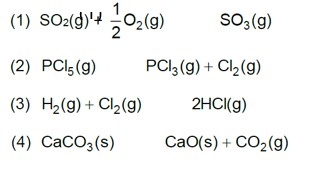An equilibrium mixture contains 2.0 moles of A(g) and 4.0 moles of B(g). Now, 2.0 moles of A(g) is added in this equilibrium mixture and the system is allowed to re-achieve equilibrium at constant volume and temperature. Now, the volume of system is doubled at constant temperature. What should be the moles of B(g) at new equilibrium? The reaction involved is
.
An equilibrium mixture contains 2.0 moles of A(g) and 4.0 moles of B(g). Now, 2.0 moles of A(g) is added in this equilibrium mixture and the system is allowed to re-achieve equilibrium at constant volume and temperature. Now, the volume of system is doubled at constant temperature. What should be the moles of B(g) at new equilibrium? The reaction involved is
.
Option 1 -
3.86
Option 2 -
5.86
Option 3 -
4.86
Option 4 -
6.58
-
1 Answer
-
Correct Option - 4
Detailed Solution:New Eqm
=
Now, KC = constant
mole of B at new Eqm = 4 + 2Z = 6.58
Similar Questions for you
0.01 M NaOH,
M = 1 * 10-2

pOH = 2
pH = 2
Kp = Kc (RT)Dng
36 * 10–2 = Kc (0.0821 * 300)–1
Kc = 0.36 * 0.0821 * 300 = 8.86 » 9
A(g) ->B(g) + (g)
Initial moles n 0 0
Eqb. moles n(1 – a) na
total moles =
Eqb. pressure
On increasing pressure, equilibrium moves in that direction where number of gaseous moles decreases.
Taking an Exam? Selecting a College?
Get authentic answers from experts, students and alumni that you won't find anywhere else
Sign Up on ShikshaOn Shiksha, get access to
- 65k Colleges
- 1.2k Exams
- 681k Reviews
- 1800k Answers


